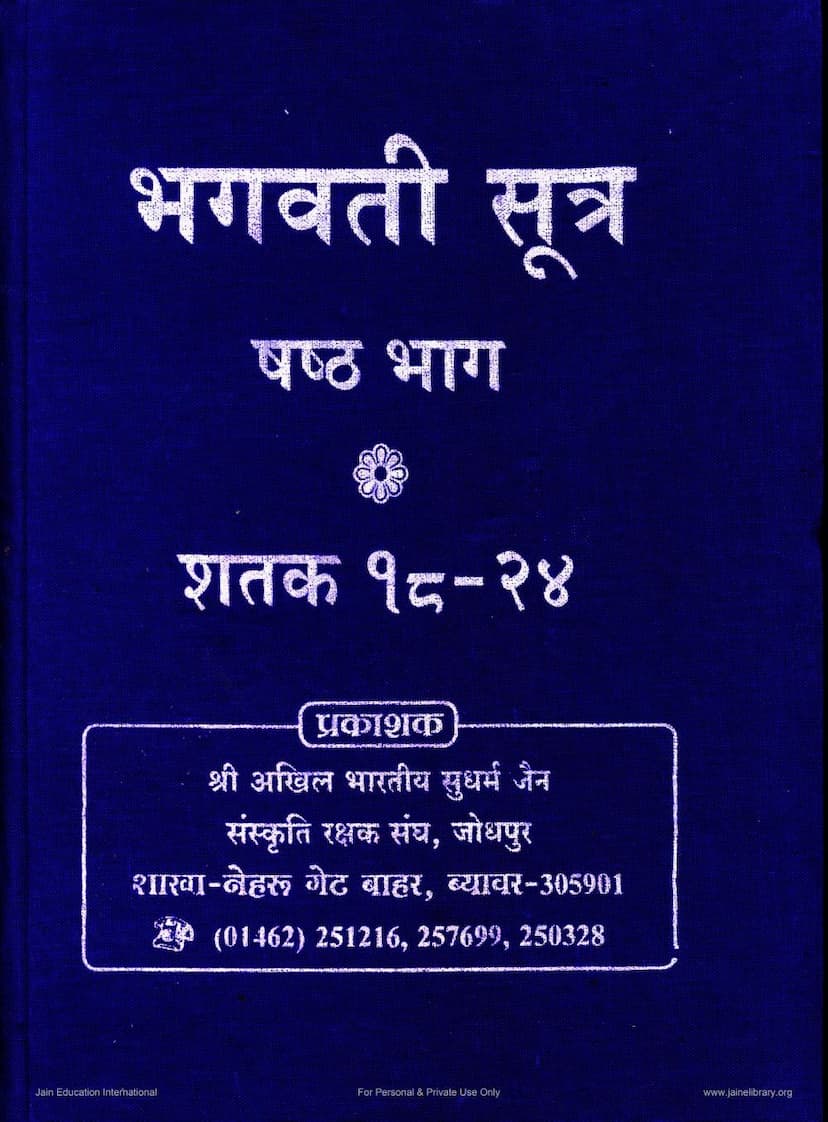Bhagvati Sutra Part 06
Added to library: September 1, 2025

Summary
This document is the sixth part of the Bhagvati Sutra, titled "Bhagvati Sutra Part 06," compiled by Pt. Ghevarchand Banthiya. Published by Shri Akhil Bharatiya Sudharm Jain Sanskriti Rakshak Sangh, Jodhpur, with a branch in Beawar, it covers Shataks (centuries) 18 through 24. The text is intended for private and personal use only.
The summary of the content, based on the provided pages, is as follows:
Overall Structure: The Bhagvati Sutra is described as a vast ocean of jewels, and this sixth part contains the explanations for Shataks 18 to 24. Each shatak is further divided into Uddeshaks (sections or topics).
Summary of Shatak Content (as outlined in the 'Nivedan' section):
-
Shatak 18 (10 Uddeshaks): Covers topics like the nature of souls (first or not first), the arrival of Lord Mahavir in Vishakha city, queries regarding the ascetic Makandi's son, sins like violence and their cessation, the nature of Asura Kumara deities, properties of jaggery and other items, views of outsiders on omniscient beings, queries about an ascetic's actions, beings and substances related to the cycle of rebirth, and questions from Somil the Brahmin.
-
Shatak 19 (10 Uddeshaks): Includes topics such as Leshya (soul coloring), conception, the nature of earth-bodied and other elemental beings, questions about 'great influx' and 'great action', the concept of the last or ephemeral, islands and oceans, residences of deities, the origin of single-sensed beings, the cause of substances, and Vanavyantara deities.
-
Shatak 20 (10 Uddeshaks): Deals with the description of beings with two senses upwards, the meaning of Akash and other substances, the essence of sins like violence, the development of senses, from atoms to infinite-souled aggregates, the intervals between realms like Ratnaprabha, the binding of karma through living beings' actions, karmic and non-karmic lands, knowledge, conduct, and the lifespan of beings with or without sopakrama (active) karma.
-
Shatak 21 (8 Vargs, each with 10 Uddeshaks): This Shatak is structured into 8 Vargs, with each Varg having 10 Uddeshaks. The Vargs focus on the origin of roots (mul) of various plants and substances:
- Varg 1: Jaggery, wheat, barley, etc.
- Varg 2: Peas, lentils, sesame, etc.
- Varg 3: Alsi (flaxseed), mustard, etc.
- Varg 4: Bamboo, sugarcane, etc.
- Varg 5: Darbh (a type of grass), Ikshu (sugarcane) derivatives, etc.
- Varg 6: Sediya, Bhandiya, Darbh, etc.
- Varg 7: Abhruha, etc.
- Varg 8: Tulsi, Krishna Dal, etc. In total, this Shatak contains 80 Uddeshaks.
-
Shatak 22 (6 Vargs, each with 10 Uddeshaks): This Shatak also has Vargs focusing on plants and their origins, but specifically on different categories:
- Varg 1: Trees like Tal, Tamal, etc.
- Varg 2: Trees with a single seed.
- Varg 3: Trees with multi-seeded fruits.
- Varg 4: Bushy plants like Ringani.
- Varg 5: Shrub-like plants like Siriaka and Navamalika.
- Varg 6: Creepers like Valli. This Shatak comprises a total of 60 Uddeshaks.
-
Shatak 23 (5 Vargs, each with 10 Uddeshaks): This Shatak has 5 Vargs, with each Varg containing 10 Uddeshaks, totaling 50 Uddeshaks. The Vargs cover:
- Varg 1: Ordinary vegetables like potatoes.
- Varg 2: Anantkaya (possessing infinite souls) substances like Lohi.
- Varg 3: Plants like Avaka.
- Varg 4: Plants like Patha and Mriglalunkee.
- Varg 5: Plants like Mashaparni.
-
Shatak 24 (24 Uddeshaks): This Shatak is structured around 24 Dandas (categories or principles). The 24 Uddeshaks are listed as:
- Upapata (Rebirth)
- Pariman (Quantity/Measure)
- Samhanan (Constitution)
- Height
- Sansthan (Form/Figure)
- Leshya
- Drishti (Viewpoint/Faith)
- Gyan (Knowledge)
- Agyan (Ignorance)
- Yoga (Activity)
- Upayoga (Consciousness)
- Sangya (Perception)
- Kashaya (Passions)
- Indriya (Senses)
- Samudghata (Emanations)
- Vedana (Sensation)
- Ved (Feeling)
- Ayushya (Lifespan)
- Adhyavasaya (Mental dispositions)
- Anubandha (Continuity)
- Kayasamvedha (Body experience)
- Upapata (Rebirth of Vana-vyantara deities)
- Upapata (Rebirth of Jyotishi deities)
- Upapata (Rebirth of Vaimanika deities) The text clarifies that these 20 aspects are discussed in relation to the 24 Dandas, with the first two relating to the place of birth, the next seventeen to the ten lives of the born being, and the twentieth to both lives combined.
Key Features Highlighted:
- Publisher: Akhil Bharatiya Sudharm Jain Sanskruti Rakshak Sangh, Jodhpur (with a branch in Beawar).
- Editor/Compiler: Pt. Ghevarchand Banthiya.
- Patronage: Financial support from Shri Jaswantlal Bhai Shah, Mumbai, is acknowledged, enabling the publication at half price.
- Content Focus: The 'Nivedan' section provides a brief overview of the topics covered in each of the seven Shataks (18-24), detailing the number of Uddeshaks and their general subject matter.
The provided text includes a 'Shuddhi-Patra' (errata) listing corrections for specific pages and lines, indicating a detailed editorial process. It also lists other Agama texts published by the Sangh, giving context to their literature dissemination efforts.